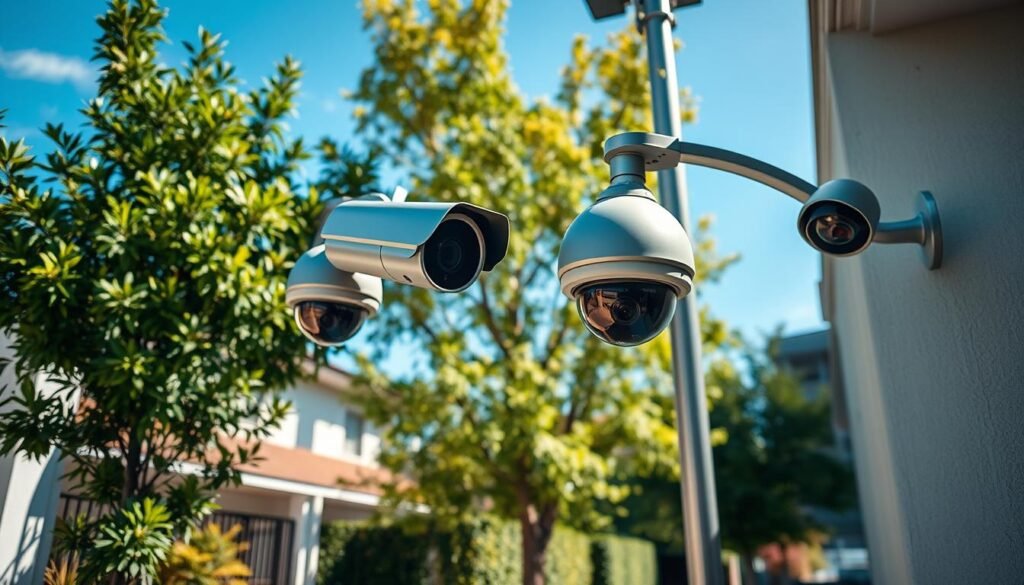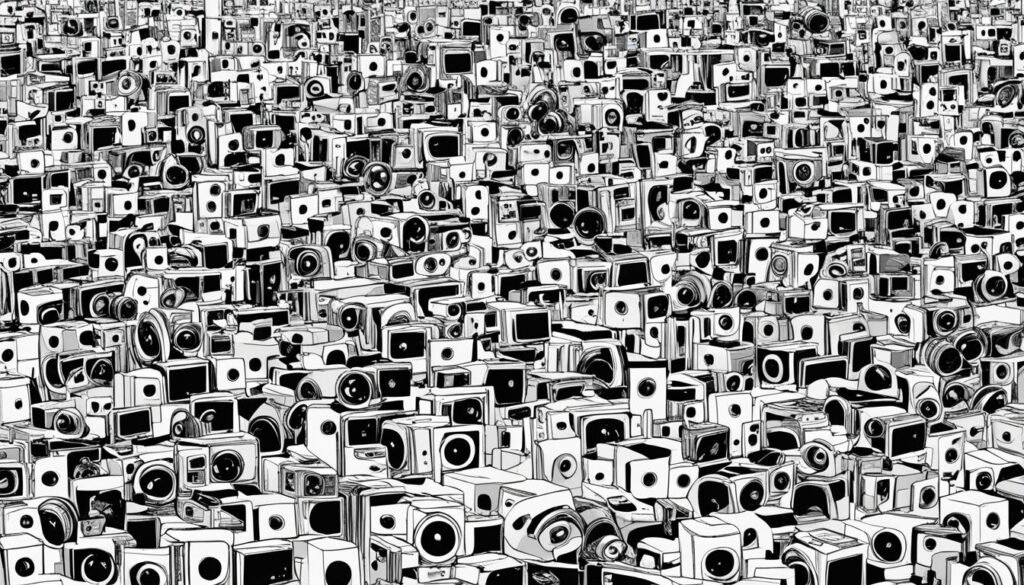Do you know your security camera might be missing key details? HD cameras are changing how we keep our homes and businesses safe. The market for video surveillance hit $53.47 billion in 2023 and is expected to keep growing.
HD surveillance cameras give clear images that help spot threats. They’re not just for recording; they give us peace of mind. They work well in low light, making them a game-changer for security experts and homeowners.
HD technology is changing how we think about safety. These cameras are vital in cities and quiet areas alike. Let’s look at how these high-tech cameras are setting new standards in security.
The Evolution of Video Surveillance Technology
Video surveillance has changed a lot since the early days of CCTV cameras. The move from analog to digital technology has changed the game. Now, analog cameras are being replaced by more advanced IP cameras.
CCTV cameras have been around for many years, offering basic video monitoring. These systems used coaxial cables to send footage to a central recording device. While they worked, they had issues with image quality and flexibility.
IP cameras brought a big change. These digital devices connect directly to computer networks, giving better image quality and remote access. Unlike analog cameras, IP cameras can send high-definition video over long distances without losing signal quality.
Today, we have a mix of analog, IP cameras, and hybrid systems. Many businesses are switching from old CCTV setups to newer IP-based systems. This change has made images clearer, systems more scalable, and easier to integrate with other security tech.
Advances like AI-powered analytics and cloud storage are pushing video surveillance further. These features are making surveillance systems smarter and more efficient than ever.
Understanding HD Surveillance Cameras: Features and Benefits
HD cameras have changed how we watch over places. They give us clear video, making homes and businesses safer. Let’s look at what makes these cameras special.
Resolution and Image Quality
HD cameras take pictures with amazing clarity. They show sharp, detailed images that are way better than old systems. This means you can easily see people and things far away.
This clear footage is key in security, where every detail is important. It helps in spotting things that could be a problem.
Night Vision Capabilities
Night vision cameras work great in the dark. They use infrared to see clearly even in total darkness. This means you can watch over your place all the time, even when it’s really dark.
Being able to see at night adds a lot of security. It keeps your property safe, even when it’s hard to see.
Wide Dynamic Range
Wide Dynamic Range (WDR) fixes problems with bright and dark areas. It stops glare and shadows that hide important details. WDR makes sure cameras work well in tough lighting, like bright lights at entrances.
This means you get clear pictures everywhere, not just in good lighting. HD cameras are a big step up in security. They offer great image quality, night vision, and handle different lights well. As technology gets better, we’ll see even more cool things in video surveillance.
Types of HD Surveillance Cameras for Various Applications
HD surveillance cameras come in many types to fit different security needs. Outdoor cameras are tough and work well in bad weather. They help keep homes and businesses safe by watching over entrances, driveways, and backyards.
Wireless surveillance cameras are easy to set up and can be moved around. They’re perfect for renters or anyone who doesn’t want to deal with wires. This flexibility makes them very useful.
Home security cameras are getting more popular. They can be doorbell cameras or indoor ones that watch over pets or kids. Many of these cameras link to smartphones, so you can check on your property from anywhere.
Businesses have special cameras with cool features like facial recognition or license plate readers. The market for video surveillance was worth $53.47 billion in 2023. This shows how much people want these security solutions.
The surveillance camera market is expected to grow by 12.98% from 2023 to 2033. This means more choices for buyers, from simple cameras to advanced systems that work with smart home tech.
Key Factors to Consider When Choosing HD Surveillance Cameras
Choosing the right business security cameras is important. You need to think about what you need and where you’ll put them.
Indoor vs. Outdoor Use
Indoor cameras are smaller and not made for the weather. Outdoor cameras can handle tough weather. They’re strong and often have special covers.
Wired vs. Wireless Options
Wired cameras have steady connections but are harder to set up. Wireless cameras are easy to put anywhere. But, they might not work well in some places.
Storage and Connectivity
Think about how you’ll store your footage. Cloud storage lets you access your videos anywhere and grow your storage. Local storage is good for keeping sensitive data safe. Some cameras let you choose between the two. The way you connect to the internet affects how you see and manage your videos.
Integration with Existing Systems
Make sure new cameras work with your security setup. This includes things like access controls, alarms, and monitoring software. It’s important for a smooth security system.
Every place is different. Plan your space and figure out where you need cameras. This way, you can make a surveillance system that fits your business perfectly.
Top Brands and Manufacturers in the HD Surveillance Camera Market
The HD surveillance camera market is filled with top brands leading the way. These companies bring the latest technology and reliable solutions for security needs.
Hikvision and Dahua are big names in the industry. They offer a wide range of high-quality cameras for homes and businesses. Axis Communications is always innovating, setting new standards in surveillance tech.
Bosch Security Systems and FLIR are known for their advanced thermal imaging. Avigilon stands out with AI-powered analytics. Hanwha Techwin is a go-to for outdoor cameras.
Honeywell Security Group, Infinova, and Pelco complete the list of top brands. Each offers unique strengths, from easy-to-use interfaces to cameras that can handle tough conditions.
When picking a brand, think about resolution, night vision, and how well it fits with your system. The best brand for you will depend on your security needs and budget.
Installation and Setup of HD Surveillance Camera Systems
Setting up an HD surveillance camera system can change how you feel about security. It requires careful planning, whether you do it yourself or hire a pro for the job.
DIY vs. Professional Installation
Doing it yourself can save money and teach you about network security. Many cameras come with apps that make installation easy. But, hiring a pro ensures your cameras are placed and set up right, especially for complex systems.
Optimal Camera Placement
Where you put your cameras is key to their success. Think about areas where a lot of people go by, like doors and important spots. You want to cover these areas well but also keep the cameras out of sight. This helps stop crime and get clear video if needed.
Network Configuration and Security
Getting your network right is crucial for your cameras to work well and stay safe. Use strong passwords and encryption to keep your feeds secure. Always update your cameras’ software to fight off cyber threats. If you’re not good with tech, getting help is a smart move.
In North America, many people choose to install cameras themselves or hire experts. The best choice depends on your skills, budget, and what you need for security.
Advanced Features of Modern HD Surveillance Cameras
HD surveillance cameras have evolved a lot. They now come with features that make security smarter and more effective. These cameras use the latest technology to protect homes and businesses.
AI-powered cameras are leading the change. They can learn and adapt to their environment. This means they can spot unusual activities quickly. They can tell the difference between a pet and an intruder, cutting down on false alarms.
Facial recognition is another key feature in modern cameras. It can identify people by their faces. This technology is great for controlling access to secure areas. It also helps find missing people or track suspicious individuals.
Motion detection has also improved a lot. New cameras can detect small movements from far away. They can ignore things like trees moving in the wind. This helps focus on real threats and saves storage space.
These advanced features make security systems more reliable. They protect the 9 million people living in gated communities across the US. With AI, facial recognition, and smart motion detection, modern HD cameras offer top-notch security for homes and businesses.
Legal and Ethical Considerations in Video Surveillance
Video surveillance brings up big questions about privacy laws and data protection. As technology gets better, finding a balance between security and personal rights is key. This part looks into the legal and ethical sides of using surveillance cameras.
Privacy Laws and Regulations
Privacy laws change from state to state and country to country. In the U.S., the Fourth Amendment stops unreasonable searches. Companies must follow rules on where cameras can go and how they record. It’s important to know the local privacy laws to follow them.
Consent and Notification Requirements
Being open is crucial in surveillance ethics. Many places need signs to tell people they’re being recorded. Some spots require people to agree before filming. Clear rules on camera use help build trust and follow the law.
Data Protection and Storage Policies
Keeping surveillance footage safe is key. This means secure storage, limited who can see it, and deleting old footage. Strong policies protect sensitive info and keep the public’s trust. Regular checks make sure these policies are still good.
Putting privacy and ethics first helps organizations use surveillance tech right. This way, they keep everyone safe while respecting personal rights. It makes a safer place for everyone.
Maintenance and Troubleshooting of HD Surveillance Cameras
Keeping your HD surveillance cameras in top shape is crucial for a secure property. Regular maintenance prevents problems and ensures clear footage. Clean the lenses with a soft cloth every month to remove dust and smudges. Check cables for wear and tighten any loose connections.
Update your camera’s software often to get new features and security updates. Test the night vision in low light. If the image quality is poor, adjust the camera’s settings or move it for better coverage.
If you’re having trouble, start with simple troubleshooting steps. Check your network settings and router if your camera loses connection. Weak signals can cause outages. For blurry images, try refocusing the lens or cleaning it. If these steps don’t help, look at your camera’s manual or contact the manufacturer for more help.
By following these tips, you’ll keep your HD surveillance system working well. This proactive approach saves time and keeps your property safe all the time.
Future Trends in HD Surveillance Camera Technology
The HD surveillance camera world is changing fast, with new and exciting things coming up. AI is going to change security systems a lot, making them smarter and more efficient. It will help cameras spot threats better and watch over things more effectively.
Cloud-based surveillance is getting popular, offering easy storage and access to footage from anywhere. By 2030, the 3D surveillance camera market could be worth billions. Companies like Hexagon AB, Honeywell, and Panasonic are leading the way, making video surveillance better than ever.
5G technology is set to change surveillance even more. It will let cameras send high-quality video in real-time, which is great for cities. The Ontario government has put $1.8 million into CCTV tech in cities.
As these technologies come together, we’ll see more advanced security systems. In the US, there were 30 million security cameras in 2019. With AI, cloud computing, and 5G, the future of HD surveillance cameras looks very promising.


